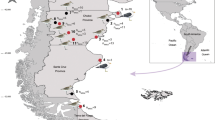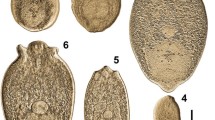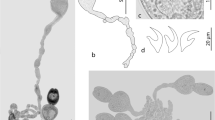Abstract
This is the first study that used species-specific DNA primers to confirm the presence of the heterophyid Ascocotyle (Phagicola) longa Ransom, 1920 in its first intermediate host. The larval stages (rediae and cercariae) of this parasite were morphologically and genetically identified in the gonad of the intertidal mud snail Heleobia australis (d’Orbigny, 1835) (Cochliopidae) in the Bahía Blanca estuary, Argentina. In addition, we asked whether the prevalence in H. australis varied between seasons. Mullets - the second intermediate host of this heterophyid - migrate in estuaries during the warmer seasons and it is expected that piscivorous birds and mammals - the definitive hosts - prey more intensively on this species at those times. Thus, the number of parasite eggs released into the tidal flat within their feces should be higher, thereby increasing the ingestion of the parasite by H. australis. We therefore expected a higher prevalence of A. (P.) longa in H. australis in the Bahía Blanca estuary during spring and summer than autumn and winter. We found that 16 out of 2,744 specimens of H. australis had been infected with A. (P.) longa (total prevalence of 0.58%). Nonetheless, the prevalence showed no significant variation between seasons. Hence, we discuss an alternative scenario where the lack of seasonal changes might be mostly related to the permanent residence of definitive hosts in the estuary and not to the seasonal recruitment of mullets. Finally, we highlight the need for more experimental and comparative approaches in order to understand the diagnosis and geographical distribution of this worldwide heterophyid.
Similar content being viewed by others
References
Alda P., Martorelli S. 2014. Larval trematodes infecting the South American intertidal mud snail Heleobia australis (Rissooidea: Cochliopidae). Acta Parasitologica, 59, 50–67
Antunes Barros L., Santos de Arruda V., Corrêa Gomes D., Magalhães Pinto R. 2002. First natural infection by Ascocotyle (Phagi-cola) longa Ransom (Digenea, Heterophyidae) in an avian host, Ardea cocoi Linnaeus (Aves, Ciconiiformes, Ardeidae) in Brazil. Revista Brasileira de Zoologia, 19, 151–155
Brandão M., Luque J.L., Scholz T., Kostadinova A. 2013. New records and descriptions of digeneans from the Magellanic penguin Spheniscus magellanicus (Forster) (Aves: Sphenis-ciformes) on the coast of Brazil. Systematic Parasitology, 85, 79–98
Carnevia D., Perreta A., Venzal J.M., Castro O. 2004. Heleobia aus-tralis (Mollusca, Hydrobiidae) y Mugil platanus (Pisces, Mugilidae), primer y segundo hospedador intermediario de Ascocotyle (Phagicola) longa (Digenea, Heterophyidae) en Uruguay. Revista Brasileira de Parasitologia Veterinária, 13, 283
Chieffi P.P., Leite O.H., Dias R.M.D., Torres D.M.A. V., Mangini A. C.S. 1990. Human parasitism by Phagicola sp. (Trematoda, Heterophyidae) in Cananesia, São Paulo State, Brazil. Revista do Instituto Medicina Tropical de São Paulo, 32, 285–288. DOI: 10.1590/S0036-46651990000400008
Dzikowski R., Levy M.G., Poore M.F., Flowers J.R., Paperna I. 2004. Use of rDNA polymorphism for identification of Het-erophyidae infecting freshwater fishes. Diseases of Aquatic Organisms, 59, 35–41
Etchegoin J.A. 1997. Sistemas parasitarios presentes en la albufera Mar Chiquita. PhD Thesis, Facultad de Ciencias Exactas y Naturales, Universidad Nacional de Mar del Plata, Argentina
González-Castro M., Macchi G.J., Cousseau M.B. 2011. Studies on reproduction of the mullet Mugil platanus Günther, 1880 (Actinopterygii, Mugilidae) from the Mar Chiquita coastal lagoon, Argentina: Similarities and differences with related species. Italalian Journal of Zoology, 78, 343–353
Hung N.M., Madsen H., Fried B. 2013. Global status of fish-borne zoonotic trematodiasis in humans. Acta Parasitologica, 58, 231–258
Martorelli S.R., Lino A., Marcotegui P., Montes M., Alda P., Panei C. J. 2012. Morphological and molecular identification of the fish-borne metacercaria of Ascocotyle (Phagicola) longa Ransom, 1920 in Mugil liza from Argentina. Veterinary Parasi-tology, 190, 599–603
Morgades D., Katz H., Castro O., Capellino D., Casas L., Benítez G., Venzal J. M., Morana A. 2006. Fauna parasitaria del lobo fino Arctocaphalus australis y del león marino Otaria flaves-cens (Mammalia, Otariidae) en la costa uruguaya. In: (Eds. R. Menafra, L. Rodriguez-Gallego, F. Scarabino and D. Conde) Bases para la conservación y el manejo de la costa uruguaya. Vida Silvestre, Uruguay, 89–96
Olson P.D., Cribb T.H., Tkach V.V., Bray R.A., Littlewood D.T.J. 2003. Phylogeny and classification of the Digenea (Platy-helminthes: Trematoda). International Journal of Parasitology, 33, 733–755
Pereira E.M., Müller G., Secchi E., Pereira Jr.J., Valente A.L.S. 2013. Digenetic trematodes in South American Sea Lions from Southern Brazilian Waters. Journal of Parasitology, 99, 910–913
Petracci P.F., Delhey K. 2005. Guía de Aves Marinas y Costeras de la ria de Bahía Blanca. Asociación Industrial Química, Bahía Blanca, 96 pp
Petracci P.F., Sotelo M., Massola V., Carrizo M., Scorolli A., Zalba S., Delhey V. 2010. Actualización sobre el estado del aposta-dero de lobo marino de un pelo sudamericano (Otaria flavescens) en la Isla Trinidad, estuario de Bahía Blanca, Argentina. Mastozoología Neotropical, 17, 175–182
Portes Santos C., Corrêa Lopes K., da Silva Costa V., Nunes dos Santos E. G. 2013. Fish-borne trematodosis: Potential risk of infection by Ascocotyle (Phagicola) longa (Heterophyidae). Veterinary Parasitology, 193, 302–306
Simões S.B.E., Barbosa H.S., Portes Santos C. 2010. The life cycle of Ascocotyle (Phagicola) longa (Digenea: Heterophyidae), a causative agent of fish-borne trematodosis. Acta Tropica, 113, 226–233
Tamura K., Dudley J., Nei M., Kumar S. 2007. MEGA4: Molecular Evolutionary Genetics Analysis (MEGA) software version 4.0. Molecular Biology and Evolution, 24, 1596–1599
Author information
Authors and Affiliations
Corresponding authors
Rights and permissions
About this article
Cite this article
Alda, P., Bonel, N., Panei, C.J. et al. First molecular identification of Ascocotyle (Phagicola) longa in its first intermediate host the mud snail Heleobia australis. Acta Parasit. 60, 791–795 (2015). https://doi.org/10.1515/ap-2015-0112
Received:
Revised:
Accepted:
Published:
Issue Date:
DOI: https://doi.org/10.1515/ap-2015-0112




